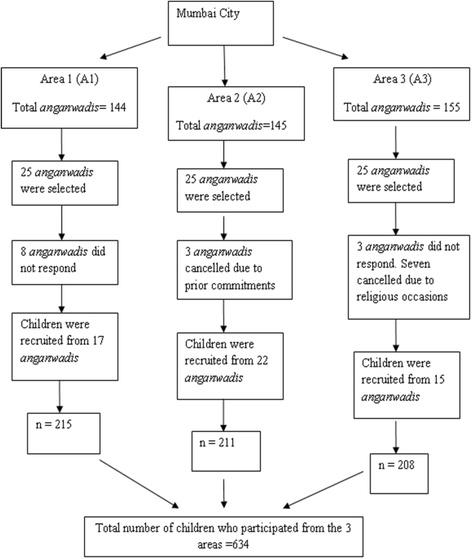Magnitude of undernutrition in children aged 2 to 4 years using CIAF and conventional indices in the slums of Mumbai city
- PMID: 26825557
- PMCID: PMC5026017
- DOI: 10.1186/s41043-015-0017-x
Magnitude of undernutrition in children aged 2 to 4 years using CIAF and conventional indices in the slums of Mumbai city
Abstract
Conventional indicators - weight-for-age, height-for-age, weight-for-height and mid-upper arm circumference (MUAC) reflect different facets of the nutritional status. Weight-for-age is the most commonly used indicator. When used individually or in combination, conventional indices fail to depict the overall magnitude of undernutrition in the population. Composite Index of Anthropometric Failure (CIAF) is an alternative classification system which attempts to fill this lacuna. Thus, we undertook this study with the objective to compare the prevalence of undernutrition using CIAF and the conventional indices. We included 634 children aged between 2 to 4 years from anganwadis located in three areas of Mumbai. Weight, height and MUAC measurements were taken. Z scores were computed for weight-for-age (WAZ), height-for-age (HAZ) and weight-for-height (WHZ) using WHO Anthro software. Children were classified as per the conventional indices and CIAF. The prevalence of underweight, stunting and wasting was 35.7%, 33.8% and 18.5% respectively. None of the children had MUAC < 11.5 cm. About 1% of the children were moderately wasted according to MUAC. As per CIAF, 47.8% children were undernourished. According to CIAF, one-third of the undernourished children had single anthropometric failure while half of them had dual failure and 17.1% had multiple failures. When compared with the conventional indices, CIAF could recognize 12.1%, 14.0%, 29.3% and 46.7% more undernourished children than WAZ, HAZ, WHZ and MUAC respectively. In conclusion, CIAF is seen to have many advantages over the conventional indices. CIAF is useful in assessing the overall magnitude of undernutrition and identifying children with multiple anthropometric failures. It also recognizes more undernourished children than all the conventional indices. Therefore, CIAF should be used more widely as a tool for nutritional assessment particularly in developing countries where the burden of undernutrition is high.
Figures
Similar articles
-
Prevalence of malnutrition in human immunodeficiency virus/acquired immunodeficiency syndrome orphans in the Nyanza province of Kenya: a comparison of conventional indexes with a composite index of anthropometric failure.J Am Diet Assoc. 2008 Jun;108(6):1014-7. doi: 10.1016/j.jada.2008.03.008. J Am Diet Assoc. 2008. PMID: 18502236
-
Assessment of malnutrition using Z-scores and Composite Index of Anthropometric Failure among street children in Delhi.Nutrition. 2024 Sep;125:112487. doi: 10.1016/j.nut.2024.112487. Epub 2024 May 8. Nutrition. 2024. PMID: 38905910
-
Assessment of undernutrition using the composite index of anthropometric failure (CIAF) and its determinants: A cross-sectional study in the rural area of the Bogor District in Indonesia.BMC Nutr. 2022 Nov 16;8(1):133. doi: 10.1186/s40795-022-00627-3. BMC Nutr. 2022. PMID: 36384860 Free PMC article.
-
Magnitudes of Various Forms of Undernutrition Among Children from the Composite Index of Anthropometric Failure in Sub-Saharan Africa: A Systematic Review and Meta-Analysis.Nutrients. 2025 May 27;17(11):1818. doi: 10.3390/nu17111818. Nutrients. 2025. PMID: 40507086 Free PMC article. Review.
-
Zinc Supplementation for Promoting Growth in Children Under 5 years of age in Low- and Middle-income Countries: A Systematic Review.Indian Pediatr. 2019 May 15;56(5):391-406. Epub 2019 Mar 17. Indian Pediatr. 2019. PMID: 30898990
Cited by
-
Spatial regression models to assess variations of composite index for anthropometric failure across the administrative zones in Ethiopia.PLoS One. 2024 Feb 28;19(2):e0282463. doi: 10.1371/journal.pone.0282463. eCollection 2024. PLoS One. 2024. PMID: 38416735 Free PMC article.
-
Disparities in childhood composite index of anthropometric failure prevalence and determinants across Ethiopian administrative zones.PLoS One. 2021 Sep 23;16(9):e0256726. doi: 10.1371/journal.pone.0256726. eCollection 2021. PLoS One. 2021. PMID: 34555038 Free PMC article.
-
Strengthening growth monitoring among under-5-year children to fight childhood undernutrition in India.J Family Med Prim Care. 2019 Jan;8(1):231-238. doi: 10.4103/jfmpc.jfmpc_225_18. J Family Med Prim Care. 2019. PMID: 30911512 Free PMC article.
-
Prevalence and Assessment of Factors Associated With Malnutrition in Children Residing in Slums of Mumbai: A Cross-Sectional Study.Cureus. 2024 Apr 19;16(4):e58619. doi: 10.7759/cureus.58619. eCollection 2024 Apr. Cureus. 2024. PMID: 38770452 Free PMC article.
-
Household Food Security, Feeding Practices, and Anthropometric Failure Among Children Aged 6-23 Months: A Hospital-Based Study.Indian J Community Med. 2025 Mar-Apr;50(2):331-336. doi: 10.4103/ijcm.ijcm_323_23. Epub 2025 Feb 1. Indian J Community Med. 2025. PMID: 40384840 Free PMC article.
References
-
- World Health Organization and UNICEF . WHO child growth standards and the identification of severe acute malnutrition in infants and children. A Joint Statement by the World Health Organization and the United Nations Children’s Fund. Geneva: World Health Organization; 2009. - PubMed
-
- Svedberg P. Poverty and undernutrition: theory, measurement and policy. New Delhi: Oxford India Paperbacks; 2000.
-
- Berger MR, Fields-Gardner C, Wagle A, Hollenbeck CB. Prevalence of malnutrition in human immunodeficiency virus/acquired immunodeficiency syndrome orphans in the Nyanza Province of Kenya: a comparison of conventional indexes with a composite index of anthropometric failure. J Am Diet Assoc. 2008;108:1014–7. doi: 10.1016/j.jada.2008.03.008. - DOI - PubMed
Publication types
MeSH terms
LinkOut - more resources
Full Text Sources
Other Literature Sources
Medical
Research Materials


